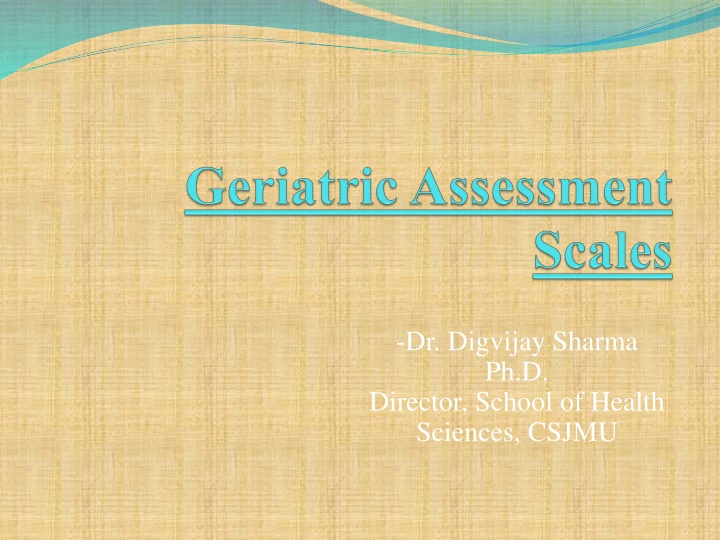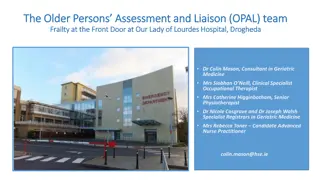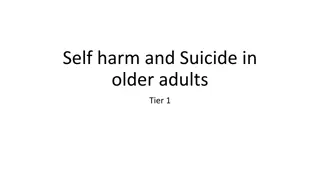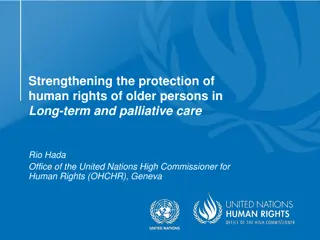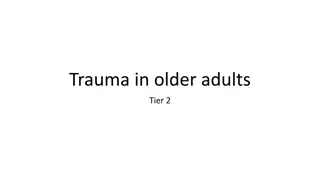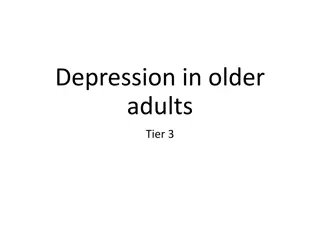Comprehensive Geriatric Assessment: Enhancing Care for Older Adults
The field of geriatrics focuses on the unique healthcare needs of older adults. Geriatric assessment involves a multidimensional approach to evaluate medical, psychological, social, and functional aspects of elderly individuals. By utilizing specific tools to assess various dimensions, including cognitive function, affective status, and nutritional health, healthcare providers gain valuable insights into managing the complex care requirements of older patients. This comprehensive assessment aids in identifying common conditions in the elderly population and tailoring individualized care plans to improve overall well-being and quality of life.
Download Presentation

Please find below an Image/Link to download the presentation.
The content on the website is provided AS IS for your information and personal use only. It may not be sold, licensed, or shared on other websites without obtaining consent from the author.If you encounter any issues during the download, it is possible that the publisher has removed the file from their server.
You are allowed to download the files provided on this website for personal or commercial use, subject to the condition that they are used lawfully. All files are the property of their respective owners.
The content on the website is provided AS IS for your information and personal use only. It may not be sold, licensed, or shared on other websites without obtaining consent from the author.
E N D
Presentation Transcript
-Dr. Digvijay Sharma Ph.D. Director, School of Health Sciences, CSJMU
Geriatrics Geriatrics is the science that deals with study of disease and their treatment peculiar to old age. United Nations (1980) considered 60 years as the age of transition to the elderly age group 1. Early old age - up to 75 years (elderly) 2. Late old age - above 75 years (very elderly)
A Multidimensional interdisciplinary diagnostic process focused on determining a frail older person s medical, psychological and functional capability in order to develop a coordinated and integrated plan for treatment and long term follow up.
In addition to medical diseases, psychological, social, cognitive, and functional issues influence the health of older persons. Therefore, the traditional medical assessment alone is often not enough to evaluate the older population with multiple comorbidities.
Geriatric assessment uses specific tools to help determine patient s status across several different dimensions, including assessment of medical, cognitive, affective, social, economic, environmental, spiritual, and functional status screening for the following geriatric syndromes: hearing impairment, vision impairment, functional decline, falls, urinary incontinence, cognitive impairment, depression, and malnutrition.
By identifying conditions that are common in the elderly, geriatric assessment can provide substantial insight into the comprehensive care of older persons, from those who are healthy and high-functioning to those with significant impairments and multiple comorbidities.
For the medical assessment, the standard physical examination and past medical history-taking is augmented by an evaluation of possible geriatric syndromes including hearing impairment, cognitive impairment, functional status, depression, falls, gait disorder, and incontinence. The social assessment involves an in-depth history-taking, which may involve obtaining information from collateral sources such as family, neighbors, and friends.
The psychological assessment includes screening for depression which complements a cognitive assessment including screening for dementia.
MEDICAL ASSESSMENT TOOLS: Patients often think that some problems, such as incontinence and falls, are a normal part of aging, and therefore are unlikely to report them as a problem to their physicians. Screening tools help to learn this information from patients
Falls/Gait Disturbance More than one-third of community-dwelling older persons fall each year, and falls are independently associated with functional decline. Also, patients who have fallen are at high risk for falling again and having resulting injuries. Because older persons frequently attribute falls to normal aging, it is very important to ask older patients if they have fallen in the last year, at their initial visit and at least annually. The use of a previsit questionnaire can help elicit this information efficiently.
Tests of gait, balance, and functional reach (Table 1) help to assess patients risk of falling. Underlying balance and gait disorders can best be detected by observing patients walking and performing balance maneuvers. To save time, this evaluation can be performed while the patient is entering or leaving the examining room.
Several additional simple tests of balance and mobility can also be performed quickly, including the ability to maintain a side-by-side, semi-tandem, and full tandem stance for 10 seconds each; resistance to a nudge; and stability during a 360-degree turn.
We can assess quadriceps strength by observing an older person arising from a hard armless chair without the use of his or her hands. Slow gait speed is also a helpful marker for recurrent falls as well as reduced survival. Patients whose gait speed exceeds 0.8 m per second are likely to live beyond the median life expectancy for age and sex, whereas those whose gait speed is <0.8 m per second are likely to have shortersurvival
The timed up and go test is a measure of the patients ability to rise from an armchair, walk 3 m (10 feet), turn, walk back, and sit down again; those who take longer than 20 seconds to complete the test should receive further evaluation as well. Patients with recurrent falls or falls with any injury should receive a more detailed evaluation, including assessment of all medications, gait and balance, orthostatic blood pressure readings, and vision testing.
Table 1: Tests of Lower Extremities: Strength, Balance, Gait, and Fall Risk
Hearing impairment ment affects up to one-third of persons aged >65 yearsHearing impair. Independently, it is associated with reduced cognitive and physical function, and reduced social involvement. It is also often under-recognized and therefore undertreated, and again often not self reported by patients One simple method for a busy practitioner is simply to rely on the patient s own subjective report of hearing loss. This involves asking patients whether they feel they have hearing impairment.
Another alternative is the whisper voice test, administered by whispering 3 to 6 random words at a set distance from the patient s ear and then asking the patient to repeat the words. Patients fail the screening if they are unable to repeat half of the words correctly. This should be done out of the patient s sight line to prevent lip reading, and the other ear should be covered.
The most accurate office test is the AudioScope, a handheld otoscope with a built-in audiometer. It should be set at 40 dB to evaluate hearing loss in older persons. A pretone at 60 dB should be delivered, with 4 subsequent tones (500, 1000, 2000, and 4000 Hz), all at 40 dB. If patients cannot hear the 1000 or 2000 Hz in both ears or both in one ear, they then need more formal audiometric testing.
Finally, a screening tool that uses sociodemographic information coupled with 3 simple questions has high accuracy in identifying older persons with hearing loss. Table 2: Tests of Hearing loss
Visual Impairment Visual impairment is a common sensory deficit in the older population; all 4 major eye diseases (cataracts, macular degeneration, diabetic retinopathy, and glaucoma) increase in prevalence with age. Most older persons have presbyopia and require corrective lenses. Visual deficiencies are also independently associated with increased risk of falling, functional decline, and depression.
The Snellen eye chart is standard method of screening for visual impairment. This requires the patient to stand 20 feet from the chart and read letters, using corrective lenses. Patients fail the screening if they are unable to read all of the letters on the 20/40 line with their eyeglasses on, and should then be referred for further evaluation by an ophthalmologist.
Given the high prevalence of eye diseases in the older population and the potential for adverse health consequences of impaired vision, a visit with an optometrist or ophthalmologist is recommended every 1 or 2 years by the American Academy of Ophthalmology and the American Optometric Association.
Urinary incontinence Urinary incontinence is under-reported as well, often due to patients embarrassment or belief that incontinence is a normal part of aging. It is a very common problem in both older men and women, and can have deleterious effects on their lives, including urinary tract infections, sleep disruption with subsequent falls, and pressure ulcers.
It is also a marker for higher mortality in older adults. There are many treatment options available, including behavioral, pharmacologic, and surgical. A simple and efficient screen for urinary incontinence is a 2-item questionnaire that can be administered by the provider: (1) In the last year, have you ever lost urine and gotten wet? If so, (2) Have you lost urine on 6 separate days?
Another single question, Have you had urinary incontinence that is bothersome enough that you would like to know how it could be treated? may convey additional value in helping to determine which patients would want further evaluation and therapy. The 3IQ questionnaire helps the clinician differentiate between urinary stress and urge incontinence using self- report questions.
Malnutrition/Weight Loss The term malnutrition has been used to refer to a wide spectrum of deficiencies (eg, proteinenergy, vitamins) and excesses (eg, obesity, hypervitaminosis) that place older persons at risk for other health conditions, functional decline, and death. Nutritional disorders are very common in older persons, the most common one being obesity (body mass index > 30 kg/m2) in community-dwelling older persons.
Obesity is associated with functional decline and more comorbidities, such as type 2 diabetes mellitus and osteoarthritis. Weight loss has commonly been used to define undernutrition and also predicts increased mortality. Although weight loss may be voluntary, any weight loss in an older person raises concern for underlying illnesses (eg, malignancy, depression) or social/functional barriers (poverty, inability to shop or prepare meals)
There are also several self-administered screening instruments available. The Mini-Nutritional Assessment predicts adverse outcomes that may or may not be related to the nutritional components of the instrument. The 4-item Simplified Nutrition Assessment Questionnaire asks about appetite and how food tastes, and has been associated with weight loss in a cross-sectional study.
Malnutrition in the hospitalized older patient is common and has been associated with higher mortality, delayed functional recovery, and higher rates of nursing-home use. Persistent decreased intake and weight loss in the hospital should prompt investigation. Malnutrition in the hospitalized older patient can also be a marker for another occult process. For example, evaluation of poor oral intake may reveal an underlying delirium or untreated pain causing decreased oral intake.
Measuring albumin and prealbumin, though not a specific indicator of malnutrition, can also be helpful in assessing prognosis. Albumin is also affected by inflammatory states related to concomitant illness, stress, and traumatic or surgical conditions. Its half-life is 18 days, and so measurement at admission may provide a nutritional baseline. Prealbumin, with a half-life of 2 days, may be more helpful to monitor response to nutritional treatment, although it is also affected by inflammatory states.
FUNCTIONAL ASSESSMENT TOOLS Functional performance can be viewed as a measure of overall impact of health conditions in the context of a patient s environment and social support system. Therefore it is essential to assess the patient s functional status at the initial visit, and any change in functional status should prompt further investigation. This can be assessed at 3 levels: basic activities of daily living (BADLs), instrumental activities of daily living (IADLs), and advanced activities of daily living (AADLs).
The BADLs are the tasks that patients need to be able to complete on their own, or have assistance to complete, in order to be able to live in their own residences: transferring, toileting, bathing, dressing, continence, and feeding. The IADLS are the abilities one needs to maintain an independent household: shopping for groceries, driving or being able to use public transportation, telephone skills, meal preparation, housework, home repair, laundry, taking medications, and handling finances.
Patients may be dependent in 1 IADLs but still able to live at home alone given they are independent in their ADLS and have family support to help pay bills, for example. Understanding the areas of impairment is essential to being able to meet the patient s needs with appropriate resources and also often helps with diagnosis.
For example, in a patient with dementia, the inability to feed oneself usually is indicative of an advanced dementia. Measurement of AADLs (societal, family, recreational, and occupational tasks) can also be helpful in detecting changes in functional status prior to onset of disability. There are several instruments that incorporate these functions into quality-of-life questions (eg, Study Short- Form 36 and Short-Form12).
Asking older persons about how they spend their day also gives insight into higher level of functioning of healthier older persons, when they are still independent in their ADLs and IADLs.
COGNITIVE ASSESSMENT TOOLS Detection of cognitive impairments early can identify treatable conditions, such as ischemic brain disease, when risk factors can be then better controlled, helping to prevent progression of disease. Detection of Alzheimer s disease can lead to appropriate pharmacologic treatment and improvements in patient safety by garnering appropriate resources to assist with ADLs and IADLs.
Early detection may also help facilitate long-term planning, including identifying preferences for care and sources of financial and caregiver support that will be important as the disease progresses. The Mini-Mental State Examination, a 30-item interviewed administered assessment, is a validated and commonly used screening tool. Expected scores are based on age and educational level. There are also several shorter validated screens for cognitive impairment listed in Table 3
These include the Mini-Cog test, which combines 3-team registration and recall with clock drawing. The clock-drawing component of these tests helps evaluate higher executive functioning and is less influenced by educational level and culture.
It is important to note that scoring perfectly on any cognitive screening test does not preclude the diagnosis of dementia. Functional-status performance is interpreted along with cognitive testing in order to diagnose level of dementia. Highly educated persons may score perfectly but have deficiencies in insight and judgment. Conversely, patients may score less than optimally on a screening test because of language barriers or education, but have good performance when tested in greater depth.
PSYCHOLOGICAL ASSESSMENT TOOLS Depression and other affective disorders are common in the older population. Moreover, older adults may not volunteer that they are depressed, but instead present with vague complaints as self-reported fatigue, or more specific symptoms of anorexia with subsequent weight loss and sleep disturbance. Therefore, it is important for physicians to screen for depression in patients for whom there is any concern.
The Patient Health Questionnaire is a validated self- administered tool. A score of >10 has a sensitivity of 88% and a specificity of 88% for major depression. A 2-item version (PHQ-2) has been used for screening. This screener asks the patient, Over the past 2 weeks, how often have you been bothered by any of the following problems? Little interest or pleasure in doing things.
Feeling down, depressed, or hopeless. Responses are scored as follows: 0 = not at all, 1 = several days, 2 = more than half the days, 3 = nearly every day. Persons who score 3 have a 75% probability of having a depressive disorder. In patients who may not be able to complete a self- administered tool (secondary to cognitive or visual impairment), the Geriatric Depression Scale may be more helpful.
This tool is physician administered with yes-or-no answers, and available in 5-item, 15-item, and 30-item versions.
SOCIAL ASSESSMENT There is a great deal of interdependency between patients social situations and their functional status. For example, persons dependent in ADLs or IADLs must have sufficient social or financial support to meet their needs. If patients are healthy but have no social support (family or friends), physicians should inquire who would help them should they have an increased level of need.
For patients who are dependent in functional activities, it is important to ask who helps them perform each specific task. A variety of private and public resources can provide further assessment if the initial screening indicates a problem. Home assessments provided by home health social worker can also help further reveal levels of support at home.
Conclusion Geriatric assessment is an essential part of the comprehensive care of older persons, from the healthy and high-functioning to those with significant impairments and multiple comorbidities. Physicians can then review areas of concern with patients at their first visit, and schedule follow-up visits to address issues further as needed.
References: 1. Reuben DB, Rosen S. Principles of geriatric assessment. In: Halter JB, Ouslander JG, Tinetti ME, et al., eds. Hazzard s Principles of Geriatric Medicine and Gerontology. 6th ed. New York, NY: McGraw-Hill; 2009. 2. Tinetti ME. Clinical practice: preventing falls in elderly persons. N Engl J Med 2003; 348: 42 49. 3. Ganz DA, Bao Y, Shekelle PG, et al. Will my patient fall? JAMA 2007; 297: 77 86. 4. Studenski S, Perera S, Patel K, et al. Gait speed and survival in older adults. JAMA 2011; 305: 50 58. 5. Podsiadlo D, Richardson S. The timed Up & Go : a test of basic functional mobility for frail elderly persons. J Am Geriatr Soc 1991; 39: 142 148. 6. Dalton DS, Cruickshanks KJ, Klein BE, et al. The impact of hearing loss on quality of life in older adults. Gerontologist 2003; 43: 661 668. 7. Reuben DB, Greendale GA, Harrison GG. Nutrition screening in older persons. J Am Geriatr Soc 1995; 43: 415 425. 8. Guigoz Y, Lauque S, Vellas BJ. Identifying the elderly at risk for malnutrition: the Mini Nutritional Assessment. Clin Geriatr Med 2002; 18: 737 757. 9. Guigoz Y. The Mini Nutritional Assessment (MNA) review of the literature What does it tell us? J Nutr Health Aging 2006; 10: 466 487. 10. O Dea D, Kokaua J, Wheadon M. SF-36 health status questionnaire. J Epidemiol Community Health 1995; 49: 647. 11. Ware J Jr, Kosinski M, Keller SD. A 12-Item Short-Form Health Survey: construction of scales and preliminary tests of reliability and validity. Med Care 1996; 34: 220 233.
